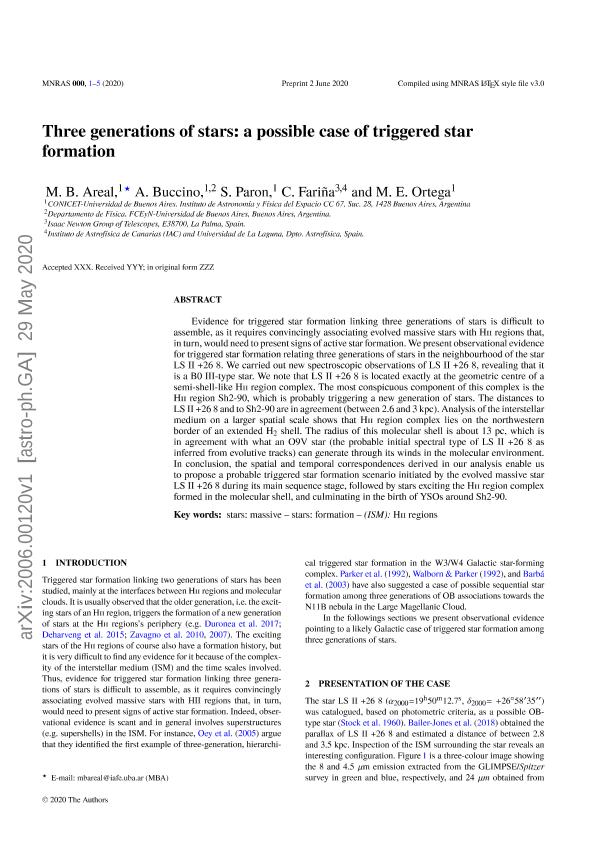Artículo
Three generations of stars: A possible case of triggered star formation
Fecha de publicación:
06/2020
Editorial:
Wiley Blackwell Publishing, Inc
Revista:
Monthly Notices of the Royal Astronomical Society
ISSN:
0035-8711
Idioma:
Inglés
Tipo de recurso:
Artículo publicado
Clasificación temática:
Resumen
Evidence for triggered star formation linking three generations of stars is difficult to assemble, as it requires convincingly associating evolved massive stars with H ii regions that, in turn, would need to present signs of active star formation. We present observational evidence for triggered star formation relating three generations of stars in the neighbourhood of the star LS II +26 8. We carried out new spectroscopic observations of LS II +26 8, revealing that it is a B0 III-type star. We note that LS II +26 8 is located exactly at the geometric centre of a semi-shell-like H ii region complex. The most conspicuous component of this complex is the H ii region Sh2-90, which is probably triggering a new generation of stars. The distances to LS II +26 8 and to Sh2-90 are in agreement (between 2.6 and 3 kpc). Analysis of the interstellar medium on a larger spatial scale shows that the H ii region complex lies on the north-western border of an extended H2 shell. The radius of this molecular shell is about 13 pc, which is in agreement with what an O9 V star (the probable initial spectral type of LS II +26 8 as inferred from evolutive tracks) can generate through its winds in the molecular environment. In conclusion, the spatial and temporal correspondences derived in our analysis enable us to propose a probable triggered star formation scenario initiated by the evolved massive star LS II +26 8 during its main-sequence stage, followed by stars exciting the H ii region complex formed in the molecular shell, and culminating in the birth of young stellar objects around Sh2-90.
Palabras clave:
H II REGIONS
,
STARS: FORMATION
,
STARS: MASSIVE
Archivos asociados
Licencia
Identificadores
Colecciones
Articulos(IAFE)
Articulos de INST.DE ASTRONOMIA Y FISICA DEL ESPACIO(I)
Articulos de INST.DE ASTRONOMIA Y FISICA DEL ESPACIO(I)
Citación
Areal, María Belén; Buccino, Andrea Paola; Paron, Sergio Ariel; Ortega, Martin Eduardo; Three generations of stars: A possible case of triggered star formation; Wiley Blackwell Publishing, Inc; Monthly Notices of the Royal Astronomical Society; 496; 1; 6-2020; 870-874
Compartir
Altmétricas




